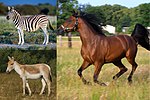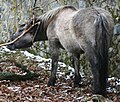Hippidion (meaning little horse) is an extinct genus of equine that lived in South America from the Late Pliocene to the end of the Late Pleistocene (Lujanian)...
14 KB (1,353 words) - 18:50, 10 July 2024
zebras of the genus Equus, with two other genera Haringtonhippus and Hippidion becoming extinct at the beginning of the Holocene, around 11-12,000 years...
4 KB (328 words) - 18:02, 11 April 2024
gomphothere (elephant-relative) Notiomastodon, the equines Equus neogeus and Hippidion, and the glyptodonts (car-sized relatives of armadillos) Glyptodon and...
24 KB (2,186 words) - 00:29, 17 July 2024
and evolved into the form currently referred to as Hippidion ~2.5 million years ago. Hippidion is thus only distantly related to the morphologically...
58 KB (6,775 words) - 07:39, 21 May 2024
†Equus major †Equus giganteus †Equus pectinatus †Equus crenidens Genus †Hippidion Genus †Onohippidium Genus †Pliohippus Although the plains and mountain...
16 KB (1,433 words) - 02:15, 1 May 2024
saber-toothed cats, ground sloths, glyptodonts, gomphotheres, the equines Hippidion and Equus neogeus, and all remaining South American native ungulates....
212 KB (19,091 words) - 10:38, 15 July 2024
Haringtonhippus. The genus is phylogenetically closer to Equus than to Hippidion. It is estimated to have diverged from modern Equus around 4.1–5.7 million...
9 KB (902 words) - 18:12, 11 April 2024
† Haringtonhippus North America extinct. c. 11,000 years ago Genus: † Hippidion South America extinct. c. 11,000 years ago Genus: † Onohippidium Genus:...
2 KB (121 words) - 02:14, 1 May 2024
their arrival to the region, they would have encountered native equines (Hippidion), the large ground sloth Mylodon, saber toothed cats (Smilodon) the extinct...
72 KB (7,675 words) - 10:47, 7 July 2024
Pleistocene wild horse genera (Equidae) Equus neogeus Hippidion Hippidion devillei Hippidion principale Hippidion saldiasi All remaining Meridiungulata genera...
202 KB (19,707 words) - 19:27, 15 July 2024
found at the site. Other animals found at the site include the equine Hippidion, the saber-toothed cat Smilodon and the litoptern Macrauchenia Diverse...
5 KB (388 words) - 20:42, 14 April 2024
separate genus was subsequently questioned. A separate genus of horse, Hippidion existed in South America. The possible causes of the extinction of horses...
54 KB (5,604 words) - 04:28, 10 July 2024
represent 5 taxa due to morphological variability, and several species of Hippidion, which also lie outside the group containing all living horses. (It had...
43 KB (4,300 words) - 22:34, 8 July 2024
a variety of large mammals, including the ground sloth Mylodon, horse Hippidion, and camelid Lama. Near his farm in mountains in Última Esperanza Province...
25 KB (2,838 words) - 12:00, 17 July 2024
analysis found it to be more closely related to living Equus than to Hippidion or Dinohippus, but outside the group containing all living equines. Some...
9 KB (992 words) - 13:53, 27 June 2024
American megafauna, such as ground sloths, gomphotheres, native equines (Hippidion) and macraucheniids; others argue that they likely represent living animals...
4 KB (367 words) - 09:46, 19 May 2024
where Fishtail points were found in association with the extinct equine Hippidion saldiasi, some of which show cut marks indicative of butchery. Evidence...
14 KB (1,572 words) - 03:56, 1 July 2024
formation: Antifer Dusicyon avus Glossotherium robustum Gomphotheridae indet. Hippidion Lestodon armatus Lundomys molitor Macrauchenia Morenelaphus Neolicaphrium...
4 KB (222 words) - 17:22, 16 July 2024
following fossils have been reported from the formation: Catonyx cuvieri Hippidion Lestodon armatus Macrauchenia Panochthus tuberculatus Smilodon populator...
5 KB (314 words) - 21:36, 8 July 2024
football league system. At the 2015 season it reached the second phase. Hippidion saldiasi Southern Patagonian Ice Field dispute Laguna del Desierto incident...
43 KB (3,368 words) - 04:28, 11 July 2024
However, recent studies of the DNA of Hippidion and other New World Pleistocene horses indicate that Hippidion is actually a member of Equus, closely...
174 KB (18,109 words) - 10:36, 23 June 2024
guanaco), cervids (e.g. Epieurycerus and Antifer), equids (e.g. Equus and Hippidion), peccaries (e.g. Catagonus), giant rodents (e.g. Neochoerus), mesotherids...
5 KB (400 words) - 16:31, 10 February 2024
recent remains at Toca do Serrote do Artur, Brazil dated to 6660-4880 BCE. Hippidion saldiasi Eastern South America Most recent remains at Cueva del Medio...
60 KB (2,737 words) - 08:06, 15 July 2024
Sarkissian, C. et al. (2015). Mitochondrial genomes reveal the extinct Hippidion as an outgroup to all living equids. Biology Letters, 11(3), 20141058...
285 KB (18,533 words) - 20:37, 18 June 2024
consisting of three genetically divergent species: the South American Hippidion, the North American New World stilt-legged horse, and Equus, the true...
87 KB (8,918 words) - 00:14, 28 May 2024
massive proboscidean Notiomastodon, and the equids Equus neogeus and Hippidion. Various artiodactyls have been recorded, including the peccaries Catagonus...
117 KB (12,956 words) - 18:01, 13 July 2024
perforatus, G. reticulatus, G. rudimentarius, Hemiauchenia paradoxa, Hippidion devillei, H. principale, Holochilus brasiliensis, Lagostomus maximus,...
312 KB (22,090 words) - 21:36, 2 July 2024
(880 lb). They were one of two groups of equines in South America, alongside Hippidion. Fossils have been recovered from the Tarija Formation of Bolivia, the...
13 KB (1,354 words) - 21:32, 3 July 2024
large share. Other finds belong to camels such as Lama, horses such as Hippidion or South American ungulates such as Macrauchenia, in addition, several...
79 KB (9,940 words) - 21:42, 3 July 2024
Piauhytherium, the macraucheniid litoptern Xenorhinotherium and equids such as Hippidion principale and Equus neogaeus. Toxodontids were large mixed feeders as...
101 KB (11,020 words) - 02:57, 8 July 2024
























